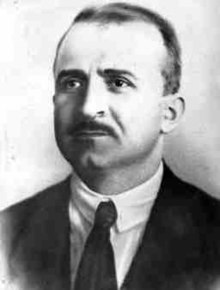Andrea Mikhailovich Razmadze (sometimes spelled Andria/Andrei Razmadze, 12 August 1889 – 2 October 1929[1]) was a Georgian mathematician, and one of the founders of Tbilisi State University, whose Mathematics Institute was renamed in his honor in 1944.[2] The department's scientific journal, published continuously since 1937, was also renamed as the Proceedings of A. Razmadze Mathematical Institute in his honor.
Andrea Mikhailovich Razmadze | |
|---|---|
ანდრია რაზმაძე | |
 Andrea Razmadze | |
| Born | 12 August 1889[1] |
| Died | 2 October 1929 (aged 40)[1] |
| Nationality | Georgian |
| Education | Moscow University |
| Known for | Calculus of Variations |
| Scientific career | |
| Fields | Mathematics |
| Institutions | Tbilisi University |
Biography edit
Andrea Razmadze was the son of Mikhail Gavrilovich Razmadze, a railway worker, and Nino Georgievna Nodia.[3] He graduated from Kutaisi nonclassical secondary school in 1906 (where Public School #41 has been renamed for him[4]), then studied at Moscow University, earning a Diploma in 1910, and then a Masters in 1917 while teaching at local classical and secondary schools.[5] At the invitation of the university, he briefly stayed in Moscow University to teach mathematics in 1917,[6] but soon left to become one of the founders of Tbilisi University.[7] Though he died just 11 years later, during his time there he greatly expanded Georgian mathematical terminology by publishing three textbooks in that language,[3] and insisting that all courses be taught in Georgian, an approach that attracted renowned mathematician Nikoloz Muskhelishvili to the school.[8] He also founded the "Georgian Mathematical Union" on 21 February 1923 and was its first president; this institution lapsed on his death, but was reorganized from 1962 to the present.[9] He is most famous for his work in the calculus of variations, where he discovered an efficient method for finding the extrema of integral functions, and a comprehensive theory for finding the extrema of discontinuous ("angular") functions that can be represented by a finite number of curves.[3] He presented this last result at the 1924 International Congress of Mathematicians in Toronto,[10] for which he was awarded a Sc.D. by the Sorbonne.[5] He also delivered lectures in Jacques Hadamard's famous seminar series in Paris, along with such notables as Paul Lévy, Laurent Schwartz, and Nobel laureates Louis de Broglie and Max Born.[11]
External links edit
- Razmadze's biography on MacTutor.
- The website of the Georgian Mathematical Union.
References edit
- ^ a b c "Dedication page to volume 63" (PDF). Memoirs on Differential Equations and Mathematical Physics. 63. Tbilisi: Razmadze Mathematical Institute: 1. 2014. ISSN 1512-0015.
- ^ "About". Andrea Razmadze Mathematical Institute. Retrieved 20 July 2016.
- ^ a b c Youschkevitch, A. P. "Razmadze, Andrei Mikhailovich". www.encyclopedia.com. Retrieved 20 July 2016.
- ^ Kutaisi Regional Selection Conference. Georgia: European Youth Parliament. 2015. p. 8. Retrieved 20 July 2016.
- ^ a b "A. Razmadze. Curriculum Vitae". A. Razmadze Mathematical Institute. Retrieved 20 July 2016.
- ^ Russian Mathematical Surveys. London Mathematical Society. 1966. pp. 87–88.
- ^ Mikaberidze, Alexander. Historical Dictionary of Georgia. Rowman & Littlefield. pp. 550–551. ISBN 9781442241466.
- ^ Maugin, Gerard A. Continuum Mechanics Through the Twentieth Century: A Concise Historical Perspective. Springer Science & Business Media. p. 189. ISBN 9789400763531.
- ^ "GMU - About Us". www.rmi.ge. Retrieved 20 July 2016.
- ^ Razmadze, Andrea M. (1925). "Sur les solutions discontinues dans le calcul des variations" (PDF). Mathematische Annalen. 94: 1–52. doi:10.1007/bf01208643.
- ^ Mazʹja, Vladimir G.; Shaposhnikova, T. O. (1999). Jacques Hadamard: A Universal Mathematician. American Mathematical Soc. p. 172. ISBN 9780821819234.